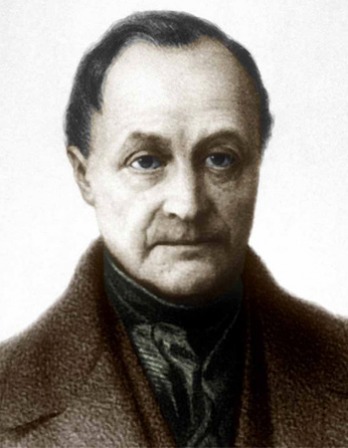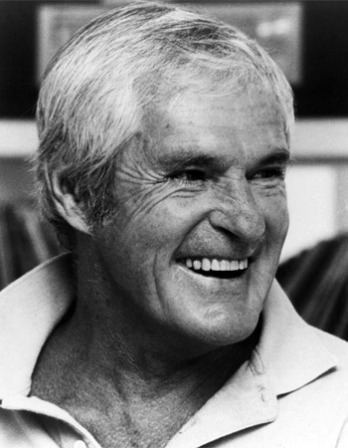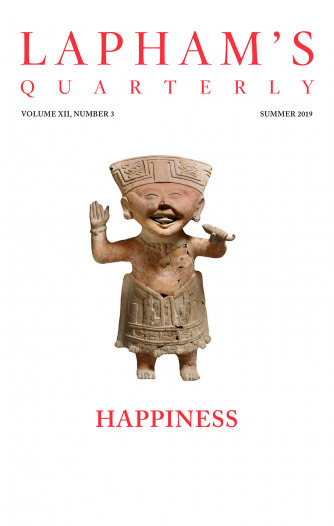What touches all shall be approved by all.
—Edward I, 1295Hiding in Plain Sight
Democracy’s indigenous origins in the Americas.
By David Graeber and David Wengrow
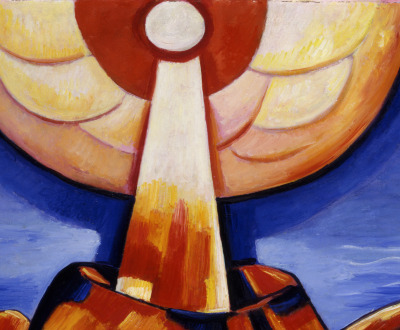
Yliaster (Paracelsus) (detail), by Marsden Hartley, 1932. Smithsonian American Art Museum, museum purchase made possible by the Smithsonian Institution Collections Acquisition Program and by George Frederick Watts and Mrs. James Lowndes, 1988.
Audio brought to you by Curio, a Lapham’s Quarterly partner
We are taught to pride ourselves on living in a democracy. At the same time, in a thousand subtle ways, we are taught that true democracy is probably impossible. Certainly, the history of democracy is always told in a manner that reminds us it is extraordinarily difficult to achieve. It is never taught, for example, as a history of habit (people collectively governing their own affairs) or of sensibility (the feeling everyone should have equal say in decisions that affect them), but rather as the history of a word: Greek δημοκρατία, Latin democratia, French démocratie. Democracy’s greatest exponents, and most bitter detractors, all claim it is a unique product of “the West,” a conceptual breakthrough—first achieved in ancient Greece, by the same people who invented “Western” science and philosophy—which then hovered around Europe for two thousand or so years as a largely unrealized potential, until a similar cohort of geniuses revived it in the French Enlightenment.
The story is so full of conceptual holes, so obviously incoherent, that it takes enormous will to hold it all together. “The West,” for instance, has to be defined in half a dozen contradictory ways: sometimes it’s an intellectual tradition, sometimes it’s geographical, cultural, racial, and so on. If any of these usages were applied consistently, the whole jerry-built apparatus would fall apart. To take just one example, if “the West” is a tradition of people reading one another’s writings, what does one do with the fact that until the eighteenth century, every author preserved in that tradition was explicitly antidemocratic? If it’s more a matter of cultural sensibility, wouldn’t the true heirs of ancient Greeks be modern Greeks? They speak the same language, after all—yet exponents of what Samuel P. Huntington called the “clash of civilizations” thesis insist modern Greeks aren’t Westerners at all, since they chose the wrong form of Christianity in the Middle Ages. (The same exponents take as epitomes of Western values David Hume and Adam Smith, whom Plato would no doubt have considered barely civilized descendants of Celtic savages.)
It all smacks of special pleading, but pleading for what? In essence, there are two subtle messages being conveyed by those who tell this story. One is that the history of democracy is ours now, in exactly the same sense as the Elgin Marbles; the other is that democracy is both highly unusual in world history and very difficult to achieve. Full, direct democracy, we are given to understand, was possible only for an extraordinary race living in an ancient city of exactly the right size. On a national scale, only the most attenuated version is possible, and we really shouldn’t blame ourselves if half the time we get it wrong; on a planetary scale, it’s obviously impossible. As late as the eighteenth century, most European political thinkers considered democracy beyond the pale. American revolutionaries like John Adams were openly against it. Only around 1800 did some start using the term democracy to relabel modern constitutional systems, which were actually designed to emulate the Roman Republic. In doing so, they created many of the conundrums we grapple with today, as when one part of the public identifies democracy with the “will of the people,” while another identifies it with institutional checks and balances on popular rule.
This whole state of affairs would have come as a surprise to Enlightenment philosophers, who were inclined to think their ideals of freedom and equality owed much to the native peoples of what they called the “New World.” Of course, they could have been more open about their influences, because “the West” had not yet been invented, and if they saw Western Europe as heir to some ancient intellectual tradition, then it was Christian theology (the very one they were trying to escape). Historians of the future may yet come to describe the origins of modern governance as a cultural composite, assembled from Amerindian notions of personal liberty, African social-contract theory, free-market economics inspired by medieval Islam, and Chinese models of the nation-state (a civil service chosen by competitive exams, administering a uniform ethnolinguistic population).
In similar fashion, one could make a case that some of the very earliest Enlightenment salons were held not in Europe but in Montreal, during the 1690s. It was there that an indigenous statesman called Kandiaronk, acting as liaison between the Wendat (“Huron”) confederation and the regime of Louis XIV, sat down regularly with the French governor-general, the comte de Frontenac et de Palluau, and his deputies—including a certain Baron de Lahontan—to debate issues such as economic morality, law, sexual mores, and revealed religion. Kandiaronk was widely hailed by French observers as the most brilliant logician and wittiest debater anyone had ever met (one slightly irritated Jesuit wrote, “No one has perhaps ever exceeded him in mental capacity”), and a book based on notes from these debates later became a best seller across Europe.
Published in 1703, Lahontan’s Curious Dialogues with a Savage of Good Sense Who Has Traveled inspired, among other things, a long-running theatrical production. Almost every major Enlightenment thinker came up with their own variant on it, featuring a foreign observer (usually Native American but sometimes Polynesian, Persian, or Chinese) who picks apart the absurdities of French society and typically apes Kandiaronk’s signature style of skeptical rationalism, his piece-by-piece dissection of Christian doctrine, advocacy of sexual freedom, and his insistence that all the social ills of Europe are ultimately rooted in inequalities of wealth. Conservative thinkers would later place blame for the violent excesses of the French Revolution directly at the feet of The Jesuit Relations and texts such as those of Lahontan, which they claimed first introduced such infectious ideas into a stable, hierarchical social order.
Over time the terms of this debate have veered to the other extreme. These days any attempt to suggest Europeans learned anything at all of moral or social value from Native people is met with mild derision and accusations of indulging in “noble savage tropes” or occasionally almost hysterical condemnation, as with the “Influence Debate,” triggered by the proposal that Haudenosaunee federal structures (the Six Nations of the Iroquois) might have been one model for the U.S. constitution.
The history of democracy is caught, it seems, in a double bind. Both those who extoll its virtues in channeling the popular will and those who see in it a means of constraining that will are likely to agree we are talking about an exclusive product of “Western civilization.” Similarly, historians confronted by clear evidence of participatory decision-making in Africa, Oceania, Asia, or the Americas typically react by shrugging it off, ignoring it, or at best emphasizing that whatever was going on, there is some technical reason why it can’t really be considered democracy. (Such stringencies, of course, are never applied to fifth-century-bc Athens: a militaristic, slave-owning society founded on the systematic repression of women.)
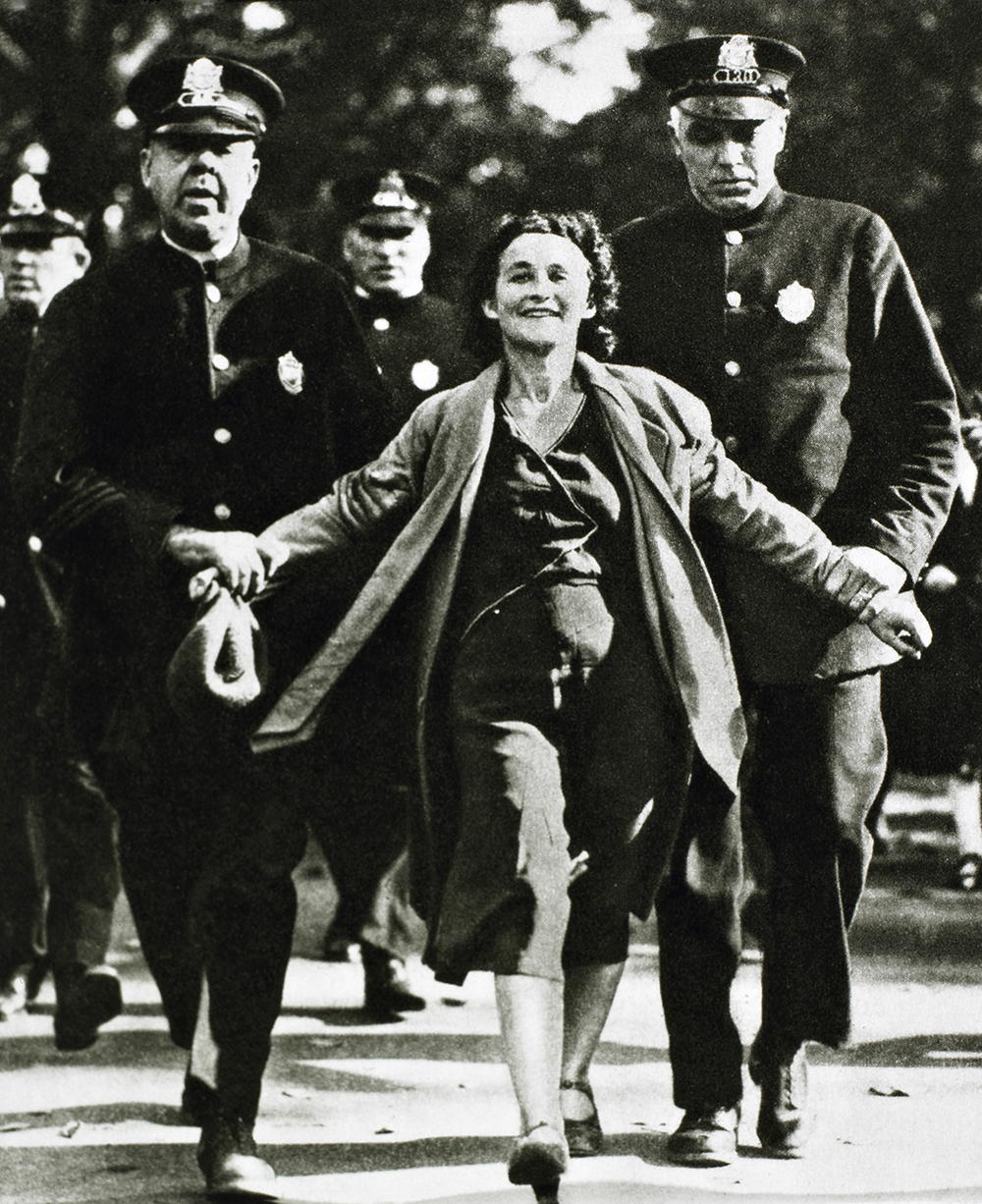
Labor organizer Edith Berkman being arrested during a textile workers’ strike, Lawrence, Massachusetts, 1933. JT Vintage / Art Resource, NY.
What would happen if we stopped doing that? One result is that the human past would start to look very different, because once you begin searching for it, evidence of democratic practice is actually much more common than one might think—it even crops up in some surprisingly pivotal moments of world history. Often it is hiding in plain sight.
Consider the case of Tlaxcala, a city-state adjacent to what’s now the Mexican state of Puebla, which played a key role in the Spanish conquest of the “Triple Alliance,” or Aztec Empire. Here is how Charles C. Mann, in his 1491: New Revelations of the Americas Before Columbus, describes what happened in 1519, when Hernán Cortés passed through:
Marching inland from the sea, the Spanish at first fought repeatedly with Tlaxcala, a confederation of four small kingdoms that had maintained its independence despite repeated Alliance incursions. Thanks to their guns, horses, and steel blades, the foreigners won every battle, even with Tlaxcala’s huge numerical advantage. But Cortés’ force shrank with every fight. He was on the verge of losing everything when the four Tlaxcala kings abruptly reversed course. Concluding from the results of their battles that they could wipe out the Europeans, though at great cost, the Indian leaders offered what seemed a win-win deal: they would stop attacking Cortés, sparing his life, the lives of the surviving Spaniards, and those of many Indians, if he in return would join with Tlaxcala in a united assault on the hated Triple Alliance.
There is a problem with this account: there were no kings in Tlaxcala. One need only compare Mann’s account, drawn from secondary sources, to the one Cortés himself addressed to his king, the Holy Roman emperor Charles V. In his Five Letters of Relation (1519–26), Cortés reported that the Valley of Puebla contained numerous cities, and the largest was pyramid-studded Cholula. He then went on to describe Tlaxcala and its hinterland, with a total population of 150,000, noting that “the order of government so far observed among the people resembles very much the republics of Venice, Genoa, and Pisa, for there is no supreme overlord.”
Cortés was a minor aristocrat from a part of Spain where even municipal councils were still something of a novelty; one might argue he had little real knowledge of republics and therefore might not be the most reliable judge of such matters. Perhaps—but by 1519 he had considerable experience in identifying Mesoamerican kings and either recruiting or neutralizing them, which is largely what he had been doing since his arrival on the mainland. In Tlaxcala he couldn’t find any. Instead, after an initial clash with Tlaxcalteca warriors, he found himself engaged with representatives of a popular urban council, whose every decision had to be collectively ratified. Here is where things become decidedly strange, in terms of how the history of these events has come down to us. Within Tlaxcala a series of debates ensued over how to relate to the Spanish newcomers. In their own way, these deliberations could well be considered pivotal events in world history, since Cortés’ eventual conquest of the Aztec capital, at Tenochtitlán, a city of perhaps a quarter-million people, would never have been possible without his Tlaxcalteca allies. Yet remarkably, historians pay little attention to them and almost entirely ignore the institutional framework in which they occurred. At the time, Tlaxcala and the Triple Alliance had been engaged in a long series of battles, which the latter liked to portray as a sort of game, the “flower wars.” Aztec elites insisted to Spanish chroniclers that they had allowed Tlaxcala to remain independent so that their soldiers would have a place to train and their priests a stockyard of human victims for sacrifice, but this was braggadocio.
In fact, Tlaxcala and its Otomí guerrilla units had been holding the Aztecs successfully at bay for generations. Their resistance was not just military. Tlaxcalteca cultivated a civic ethos that worked against the emergence of ambitious leaders, and hence potential quislings—a counterexample to Aztec principles of governance. Politically, the cities of Tenochitlán and Tlaxcala embodied opposite ideals. Little of this history is known, because the story we’ve become used to telling about the conquest of the Americas is one of manifest destiny: an invisible army of Neolithic Old World microbes, marching alongside the Spaniards, carrying waves of smallpox to decimate indigenous populations, and a Bronze Age legacy of metal weapons, guns, and horses to shock and awe the helpless natives.
We like to tell ourselves that Europeans introduced the Americas not just to these agents of destruction but also to modern industrial democracy, ingredients for which—it’s claimed—were nowhere to be found there, not even in embryo. All this supposedly came as a single cultural package: advanced metallurgy, animal-powered vehicles, alphabetic writing systems, and a certain penchant for freethinking that is seen as necessary for technological progress. “Natives,” in contrast, are assumed to have existed in some sort of alternative, quasi-mystical universe. They could not, by definition, be arguing about political constitutions or engaging in processes of sober deliberation over decisions that changed the course of world history; and if European observers report them doing so, they must either be mistaken or were simply projecting onto “Indians” their own ideas about democratic governance, even when those ideas were hardly practiced in Europe itself.
In the case of Tlaxcala, we have a source that records actual debates taking place in the council: the unfinished Crónica de la Nueva España, composed between 1558 and 1563 by Francisco Cervantes de Salazar, a native of Toledo who became one of the first rectors of the University of Mexico. For over four centuries, the Crónica was hiding in plain sight. Condemned to obscurity by an Inquisition keen to expunge records of “idolatrous practices,” it languished in private collections, eventually finding its way into the Biblioteca Nacional in Madrid, where in 1911 it came to light through the efforts of Zelia Nuttall, pioneering archaeologist, anthropologist, and finder of lost codices. In 1914 the Crónica finally saw publication. To this day there is no critical introduction or commentary to guide readers through its prose or point them to its significance as a record of political affairs in an indigenous Mesoamerican city.
The Crónica deals directly with the governing Council of Tlaxcala and its deliberations over the Spanish invaders. Here Cervantes de Salazar is basing his account on historical data obtained from native leaders who survived the conquest and their immediate descendants. We have accounts of speeches and diplomatic gifts going back and forth between Spanish representatives and their Tlaxcalteca counterparts, whose oratory in council occasioned admiration. Those who spoke for Tlaxcala included elder statesmen—such as Xicotencatl the Elder, father to the military general also named Xicotencatl, who is still lionized in the state of Tlaxcala to this day—but also indigenous masters of commerce, religious experts, and the top legal authorities of the day. What the author describes in these remarkable passages is evidently not the workings of a royal court but a mature urban parliament that sought consensus for its decisions through reasoned argument and lengthy deliberations, carrying on, when necessary, for weeks at a time.
The key segments of the text come in book three, when Cortés is still encamped outside the city, with his newfound Totonac and Cempoalan allies. A lord named Maxixcatzin—well known for his “great prudence and affable conversation”—gets the ball rolling with an eloquent appeal for Tlaxcaltecas to follow what is ordained by the gods and ancestors and ally with Cortés to rise up against their Aztec oppressors. His reasoning is widely accepted, until Xicotencatl the Elder—by then over a hundred years old and almost blind—intervenes. Nothing, he reminds the council, is harder to resist than an “enemy within,” which is what the newcomers will likely become if welcomed into town. Why, asks Xicotencatl,
does Maxixcatzin deem these people gods, who seem more like ravenous monsters thrown up by the intemperate sea to blight us, gorging themselves on gold, silver, stones, and pearls; sleeping in their own clothes; and generally acting in the manner of those who would one day make cruel masters…There are barely enough chickens, rabbits, or cornfields in the entire land to feed their bottomless appetites, or those of their ravenous “deer” [Spanish horses]. Why would we—who live without servitude and never acknowledged a king—spill our blood, only to make ourselves into slaves?
We paraphrase here from the Spanish, as there has been no translation of the Crónica into English. Members of the council, we learn, were swayed by Xicotencatl’s words: “A murmur began among them, speaking with each other, the voices were rising, each one declaring what he felt.” The council was divided. What followed would be familiar to anyone who has participated in a process of consensus decision-making: when matters come to loggerheads, rather than putting it to a vote, someone proposes a creative synthesis. Temilotecutl, one of the city’s four senior justices, stepped in with a cunning plan. To satisfy both sides of the debate, Cortés would be invited into the city—but as soon as he entered Tlaxcalteca territory, the city’s leading general, Xicotencatl the Younger, would ambush him with a contingent of Otomí warriors. If the ambush succeeded, they would be heroes; if it failed, they would blame it on the uncouth and impulsive Otomí, make their excuses, and ally themselves with the invaders. Incidentally, Xicotencatl the Elder was quite right about what would happen. It didn’t take long after the conquest of Tenochtitlán for Tlaxcala to lose its privileges and exemptions with the Spanish Crown, reducing its populace to just another source of tribute.

View of the Acropolis at night, Athens, c. 2010. Album / Art Resource, NY.
Such accounts have not fared well in the hands of modern historians. Most dismiss them as the author’s fantasy projection of some scene from an ancient Greek agora or Roman senate, but this in itself requires an extraordinary stretch of the imagination, since the Council of Tlaxcala continued to sit well into the colonial period. Its proceedings, and the facility of its politicians in reasoned debate, are recorded in the sixteenth- and seventeenth-century Tlaxcalan Actas, another source modern historians have tended to brush aside, insisting that “astute Indians” simply adopted European democratic mores (though these barely existed in Europe at the time) so as to impress their new overlords (who were, in fact, resolutely antidemocratic and unlikely to be charmed). To suggest otherwise is to leave oneself open to accusations of naive romanticism.
A much stronger case can be made that the deliberations recorded in Spanish sources are exactly what they seem to be: a glimpse into the indigenous mechanics of collective urban government. If in some ways they resemble debates in Thucydides or Xenophon, this is because there are really only so many ways to conduct a political debate. Another source provides confirmation. In 1541 Friar Toribio de Benavente—called Motolinía (the “afflicted one”) by locals—completed an account of Tlaxcala’s constitution that explains some of its underlying ideology. The city, he wrote, was indeed a republic, governed by a council of elected officials (teuctli), answerable to the common citizenry. How many sat on the high council of Tlaxcala is not clear; sources indicate from fifty to two hundred. Nor does Motolinía explain how they were selected or who was eligible (other Pueblan cities rotated official duties among representatives of urban wards, or calpulli). On the topic of Tlaxcalteca modes of political training and instruction, however, his account comes alive.
Far from being expected to demonstrate personal charisma or the ability to outdo rivals, those who aspired to a role on the Council of Tlaxcala did so in a spirit of self-deprecation—even shame—and were required to subordinate themselves to the people of the city. To ensure this was no mere show, each was subject to trials, starting with mandatory exposure to public abuse, regarded as the proper reward of ambition, and then—with one’s ego in tatters—a long period of seclusion, where the incumbent politician suffered ordeals of fasting, sleep deprivation, bloodletting, and a strict regime of moral instruction. The initiation ended with a “coming out” of the newly constituted public servant amid feasting and celebration. Clearly, taking up office in this indigenous democracy required personality traits very different from those we take for granted in modern electoral politics.
Cortés may have praised Tlaxcala as an agrarian and commercial arcadia, but as Motolinía explains, when its citizens thought about their own political values, they actually saw them as coming from the desert. Like other Nahuatl speakers, including the Aztec, Tlaxcalteca liked to claim they were descended from the Chichimec. Considered the original hunter-gatherers, the Chichimec lived ascetic lives in deserts and forests, dwelling in primitive huts, ignorant of village or city life, rejecting corn and cooked food, bereft of clothing or organized religion, and living on wild things alone. The ordeals endured by aspiring councillors in Tlaxcala were reminders of the need to cultivate Chichimec qualities—though these were ultimately to be balanced by the Toltec virtues of an urbane warrior.
Spanish friars no doubt heard echoes here of Old World tropes for republican virtue, that same atavistic streak running from the biblical prophets through Ibn Khaldun, not to mention their own ethic of world renunciation. The correspondences are so close that one begins to wonder if the citizens of Tlaxcala actually did present themselves to Spaniards in terms they knew would be instantly recognized and appreciated. Certainly, they staged some remarkable theatrical spectacles for the benefit of their new overlords, including a 1539 pageant of the Crusades, The Conquest of Jerusalem, in which the climax was a mass baptism of (actual) pagans, dressed as Moors. Perhaps Spanish observers even learned from Tlaxcalteca or Aztecs what it means to have once been a “noble savage”—but we digress.
Amid all this mutual positioning, what can we really conclude about the political constitution of Tlaxcala at the time of the conquest? Was it really a functioning urban democracy? If so, how many other such might have existed in the pre-Columbian Americas? Or are we confronting a mirage, a strategic conjuring of the “ideal commonwealth,” supplied to a receptive audience of millenarian friars? Were elements of history and mimesis both at work? If all we had to go on were written sources, there would always be room for doubt. But archaeologists confirm that by the fourteenth century the city of Tlaxcala was, in fact, already organized on an entirely different basis than Tenochtitlán, for example. There is no sign of a palace or central temple and no major ball court (an important setting for royal ritual in other Mesoamerican cities). Instead, archaeological survey reveals a cityscape given over almost entirely to the well-appointed residences of its citizens, constructed to uniformly high standards around more than twenty district plazas, all raised up on grand earthen terraces. The largest municipal assemblies were housed in a civic complex called Tizatlan, which was located outside the city itself, with spaces for public gatherings entered via broad gateways.
Was Tlaxcala unique? It seems unlikely. Democratic city-states rarely appear in total isolation. The archaeological evidence is important here, because it gives us some idea what the remains of a democratic polity in Mesoamerica might look like, even in the absence of written sources. Identifying a royal capital is usually more straightforward. Mesoamerican kings, like most other kings, tended to make spectacles of themselves; one can normally expect to find not just palaces and pyramid temples but also ball courts, images of war and subjugation, stelae showing rulers dominating captives (often sacrificed after games), calendrical rituals celebrating royal ancestors, and records of the deeds of living kings. But there are also ancient Mesoamerican cities where none of these things appear, or at least where they are absent for many centuries.
The worship of opinion is, at this day, the established religion of the United States.
—Harriet Martineau, 1839The oldest and grandest is Teotihuacán, which had its heyday between 100 and 600. With around a hundred thousand inhabitants, it became the largest city in the Americas, and one of the largest in the world at that time. In its early centuries, the city developed as one might expect of a budding royal center. Great twin pyramids went up, along with the Temple of the Feathered Serpent, each major building project sanctified by human sacrifices, evidence of which is recovered from their foundations. Then around 300 something changed. The temple was defaced and set alight, human sacrifices came to an end, and construction came to focus on some hundreds of spacious, stone-built apartments—midway between social housing and tiny palaces—all arranged on a grid system, built to a common design. From then on there is no further indication of central authority, nor any ostentatious signs of inequality, within the city.
Are the ruins of Teotihuacán testimony to an early social revolution? Was the city democratically administered in its later phases? We cannot say for sure, but what we can say is that the context for such debates is changing. Aside from later examples in the Americas, contemporary research in Eurasia is beginning to show that long before fifth-century Athens, egalitarian cities and participatory forms of government were surprisingly common—the first urban cultures of Mesopotamia, Ukraine, and the Indus Valley, for instance, and also other cases of social revolution, like the Chinese city of Taosi at around 2000 bc. Again, future historians will likely see the origins of modern nation-states very differently than the way we do now. Equally, it seems, they will need to abandon an Elgin Marbles view of the past and make space for entirely new histories of democracy.

This essay appears in Democracy, the Fall 2020 issue of Lapham’s Quarterly. The issue is made possible by a generous grant from the John S. and James L. Knight Foundation.

